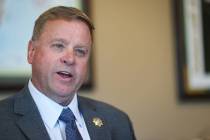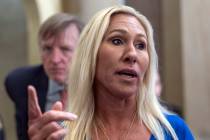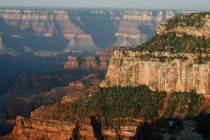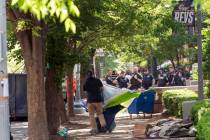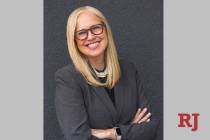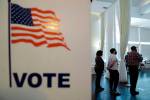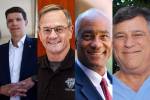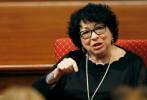Parties don’t regret hours spent in caucus building
It is a truth universally acknowledged that if tens of thousands of people do not show up at the Democratic and Republican caucuses on Jan. 19, the parties will have failed.
But why?
While the Nevada Democratic Party and the Nevada Republican Party have taken on substantial responsibility for raising awareness and encouraging participation in the first-time event among their partisans, it's not really their job.
In Iowa, the state whose caucuses are the near-exact template for Nevada's, the turnout effort falls to the campaigns and interest groups. After all, it's the candidates and issue advocates who have something at stake.
"In 2004, we did no turnout, no GOTC (get-out-the-caucus) at all," said Jean Hessburg, the Des Moines-based Democratic operative who ran the 2004 Iowa caucuses and now is the director of Nevada's first-time effort.
"We don't do turnout in Iowa because the campaigns do turnout, but it has been a 30-year effort in Iowa, and I can't tell you if in 1976 they did turnout," she said of Iowa's first time. "In Nevada, we knew we were going to put a chunk of money in the budget for turnout, but we at the Democratic Party shouldn't do 100 percent of the turnout and we won't do 100 percent of the turnout."
Senate Majority Leader Harry Reid, D-Nev., last week said he expected 100,000 Democrats to caucus, a number the party locally had been distancing itself from. Reid's comments prompted another round of doubts about whether the Nevada Democratic Party could meet what is seen as an unrealistic target.
The parties certainly can help, and in Nevada they probably want to take a more active role because it is the state's first early caucus, said Jennifer Duffy, analyst for the Washington-based Cook Political Report. But "these guys are getting unnecessarily set up," she said, with all the responsibility for caucus turnout.
"It is up to the campaigns," she said. "That's exactly who does it in Iowa. That's who should do it. The whole purpose of the caucus is for campaigns to get as many people there as they can to support their cause."
Both parties have been sweeping the state conducting "mock caucuses" to show their partisans how it's done, and both plan to do mass mailings as well. Democrats and Republicans have collaborated on an on-demand cable segment about the caucuses.
But party leaders continually face questions about whether they're doing enough. "People seem to forget that campaigns drive turnout," said GOP Executive Director Zac Moyle.
"It's really up to the campaigns to get people there (to the caucuses)," he said. "We know our grass-roots base is going to turn out, the 2,000 to 5,000 people who do it every year. But beyond that, the campaigns have to go out and find people and turn them out if they want to win."
LETTER FROM ELKO
Elko's the kind of small town where you know your neighbors. Nobody's too far apart. And that applies especially to political campaigns.
Last week, New York Sen. Hillary Clinton and former North Carolina Sen. John Edwards became the latest candidates to open campaign offices in the northeastern mining burg of 18,000, where everyone wears cowboy boots and even the brothels are picturesque. They joined Illinois Sen. Barack Obama and New Mexico Gov. Bill Richardson, giving Elko a whopping four presidential campaign offices, all belonging to Democrats.
Chances the four campaigns will be able to avoid each other are slim: Edwards moved into the same building as Richardson, and Clinton took an office next door to Obama's and around the corner from the other two.
"The Edwards people just signed the lease, and from what I understand, they'll be one floor below us," said Lance Whitney, a former chair of the Elko County Democratic Party who is working for the Richardson campaign.
"We're in the historic Henderson Bank building. It has marble floors -- it's gorgeous," he said. "Our corner office on the second floor overlooks the whole city." That ought to make Las Vegas campaign workers, in their sterile, mostly windowless office-park suites, envious.
Whitney said he tweaked a friend who works for Obama when the Clinton campaign moved in next door. "So it's sort of poetic justice" that Whitney now is getting another campaign for a neighbor.
The presence of so many Democratic campaigns upsets some Elkoans who are "trying to hang on to their Republican roots," but Whitney said that number is dwindling.
"I run into Republicans here all the time asking me how they can change their party registration," said Whitney, who grew up in Elko. "There isn't a single Republican campaign here. It's signaling to them who values their vote."
POLL-LAND
If the Nevada caucuses were held today, the 2008 election would be a Subway Series, and it would probably go seven games, according to a poll commissioned by CNN to coincide with last week's debate.
Nevada Democrats would choose Clinton, while Republicans would choose former New York Mayor Rudy Giuliani, according to the Opinion Research Corp. telephone survey of 389 likely Democratic caucus-goers and 304 likely Republican caucus-goers, conducted Nov. 9-13.
Clinton ran away with the Democrats, drawing 51 percent in the poll that carried a margin of error of plus or minus 5 percentage points. Obama trailed with 23 percent, while Edwards had 11 percent.
The Republican side was closer: Giuliani 29 percent, former Massachusetts Gov. Mitt Romney 21, former Tennessee Sen. Fred Thompson 14, Arizona Sen. John McCain 12.
No other candidates on either side topped 10 percent, although Texas Rep. Ron Paul, who has recently ramped up organizing in the state, came close with 8 percent.
Democrats liked Clinton primarily because they saw her as most electable: 63 percent believed that was the case. She was also the leading candidate in questions about leadership, qualification, ability to bring change, having clear positions, forthrightness, likability and honesty.
The latter was her weakest category, with only 37 percent saying Clinton was the most honest. Obama had 24 percent, Edwards 13 percent.
Similarly, Giuliani did best on the electability question. He was also the leading candidate in all the other categories except honesty, where Romney beat him.
In hypothetical general election matchups, Giuliani edged Clinton in a statistical dead heat, 47 percent to 46 percent, while Clinton beat Romney 51 percent to 42 percent.
Sixty percent of all likely caucus-goers believe the early contest will be good for Nevada, while 37 percent say it won't make a difference. Democrats were more bullish on the caucus than Republicans. Fifty-six percent overall said they understood the caucus rules very or fairly well, with 43 percent confused and similar percentages in both parties.
Three-quarters of those surveyed opposed driver's licenses for illegal immigrants. Among Democrats, two-thirds were opposed to such a proposal, while among Republicans, it was 85 percent.
The survey was of 2,084 adults. Of those, 389, or 19 percent, were likely to participate in the Democratic caucus; 304, or 15 percent, would likely participate in the Republican caucus.
Contact reporter Molly Ball at mball@ reviewjournal.com or (702) 387-2919.
2008 ELECTIONSGet more news, voter information









